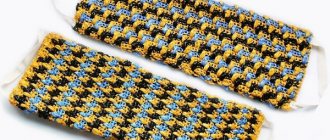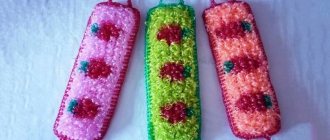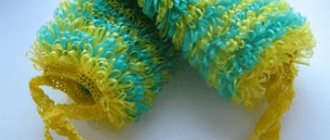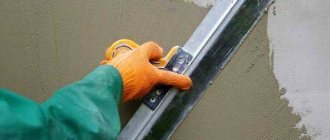Luffa is an annual plant of the Cucurbitaceae family. This unusual vine with long fruits came to us from the subtropics of Asia and has long been loved by many gardeners. Young luffa fruits can be eaten like cucumbers, and the ripe ones make wonderful natural washcloths.
The Luffa genus includes more than 50 species, among which the most popular are the sharp-ribbed and cylindrical luffa. Luffa fruits are shaped like cucumbers, their length can be 30-50 cm, and sometimes more.
Ribbed luffa
Dietary luffa fruits, when unripe, have delicate, sweetish pulp and are used in cooking for preparing salads, soups and side dishes. Greens are rich in carotene, potassium, calcium, magnesium, phosphorus, iron and contain B vitamins. As the fruits ripen, the pulp becomes fibrous and, after processing, is suitable for making washcloths, rugs, mattresses and even hats.
Seed selection
Loofahs are grown from seeds, so that's all you need to get started. It is a plant closely related to the pumpkin, Luffa aegyptiaca (commonly known as angular luffa, ribbed luffa, Chinese okra or vegetable gourd) and L. acutangular, also sometimes referred to as L. cyclindrica (commonly known as smooth luffa, Egyptian luffa or pumpkin gourd), both are sold as luffa.
When you buy a packet of luffa seeds, it may not indicate which seeds you are getting. The two types are pretty much interchangeable, so you don't have to worry about the details. Both are tall - at least 2-3 meters in length - annual vines with beautiful yellow flowers. The appearance of the fruit depends a little on the variety you plant: slanted luffa fruits have longitudinal ridges separated by deep grooves; The smooth luffa fruits have only shallow folds along the length of the fruit. Depending on the variety, the fruit can reach from 30 to 90 centimeters in length. If you have a choice, a smooth luffa is a better choice for sponges.
Varieties of loofah
The first thing you should do is decide what type of loofah maker you want to be.
- Are you most interested in growing them for food?
- Are you dreaming of collecting a sponge to make eco-friendly and eco-friendly products for your home?
Or, if you're like me, you might want to do both!
Some varieties of loofah are better than others for specific uses.
For example, some loofahs have a bitter skin and do not taste good; others will be tasty, but may be too small or awkwardly shaped for ideal home use.
When I set out to grow loofah, I spent hours trying to figure out the difference between the seeds and the species, but everything I read only made me more confused.
The simplest and most useful distinction I've found is the "angular" loofah vs. the "smooth" loofah.
- The corner loofah (often sold as "Chinese okra") has ridges on the gourd and is the most popular eating loofah.
- Smooth loofah (sometimes called "pumpkin gourd") is most commonly grown for sponging.
Of course, there are many other varieties suitable for each use. But if you're just starting out, understanding the basic varieties—corner or smooth, or "Chinese okra" or "dish squash"—will make your life a lot easier!
Don't worry, you'll learn the intricacies of loofahs so you can develop your personal preferences as you become a more proficient loofah maker.
Planting luffa seeds
Loofah seeds can take up to 150 or even 200 warm days to germinate, grow into a vine, flower and produce a sponge ready for harvest, so most gardeners in colder climates start luffa seed seedlings indoors in tall pots (12-15 cm.) approximately 4-6 weeks before the last possible spring frost. Gardeners in warmer zones can plant seeds directly into the soil or into an outdoor container if the weather is warm in late spring. For good germination, the temperature of the soil, not the air, must be at least 21 degrees. Don't rush, the seeds are more likely to rot than to germinate.
Use in folk medicine
Egyptian luffa fruits and seeds have shown antimicrobial potential and antioxidant effects. The juice of the plant is indicated for use internally to combat jaundice, as well as externally for treating animal bites and disinfecting ulcers.
The seeds are classified as laxatives and emetics, and the fruits are classified as sedatives, diuretics, and dietary products.
In India, Iraq, and Iran, the roots of the plant are used for dropsy. In Bangladesh, a decoction of the leaves is prescribed for people suffering from uremia, amenorrhea, hemorrhoids and leprosy. Seed oil improves the condition of the skin and is used for dermatitis. In West Africa, the juice of the leaves is used to wash the eyes for conjunctivitis. In Mauritius, the seeds are eaten to suppress the growth of worms.
Tips for growing luffa
- Germination can take up to 14 days, so patience is required.
- Before planting, soak the seeds overnight in a glass of water to speed up germination.
- Plant 3 or 4 seeds a few centimeters apart in a group, pushing them 1 centimeter into the soil.
- Create spatial groups at a distance of 15 to 20 centimeters
- Once the plants reach 30 cm in height, thin out the smaller seedlings from ground level, leaving only the strongest to grow, one or two per group.
Planting seedlings
It is recommended to plant loofahs near gazebos or high fences. For a free-standing plant, you will have to embed a long support column into the ground. It is better to prepare the place in the fall. To do this, dig small holes in the designated places and fill them with rotted manure and ash. Let us remind you that the minimum distance between adult plants should be 1 m, this must be taken into account.
Move the seedlings into open ground in the spring at an average daily temperature of +14-16° C. If plastic cups were used, the plant must be removed carefully so as not to damage the roots. We recommend watering the seedlings - in this case, the root ball will not be disturbed, and the plant will quickly take root in its new location.
How to get large fruits
In order to please the size of the fruit in the future, you should not allow the luffa to develop in height and form a large number of ovaries. When the vine has stretched 4 m, the central trunk must be pinched. At least once every 30 days, feed the pumpkin with a solution of manure and ash (add 1 liter of soaked chicken droppings and a 0.5-liter jar of wood ash to 10 liters of water).
If all recommendations are followed, gardeners will receive a decent harvest in early autumn. If you grew a cylindrical variety, then after collecting the pumpkins, they need to be placed in a ventilated, warm room and dried thoroughly. When the rustling of the seeds inside the workpiece is heard when shaking, it’s time to start making the washcloth.
Luffa Vine Care
Keep weeds under control by pulling them or covering the area with organic mulch.
Water the plants deeply if there is no rain for several days or if the leaves wilt.
Once the flowers begin to appear, you may notice that some of them have tiny green pumpkins attached to them and some do not. This is normal: pumpkins have male and female flowers. Female plants have tiny pumpkins that will develop when the flower is pollinated, while male plants exist only to produce pollen and die.
If you have flowers with tiny pumpkins, but the pumpkins simply shrivel after the flower closes, you may not have enough bees or wild pollinators tending your vine. In this case, you can play bee by picking a male flower (without the tiny pumpkin underneath) that has just opened, and rubbing its dusty pollen center against the sticky nub inside the center of any female flowers that opened that day.
To maintain beauty
Luffa is used not only in cooking, folk medicine and farming, it is an indispensable product in cosmetology, on the basis of which moisturizing masks, toning lotions and cleansing compositions for the care of normal and oily skin are prepared. Before performing the procedure, thoroughly wash away dust, dirt, and remaining fat accumulated during the day from the surface of the dermis.
Best materials of the month
- Coronaviruses: SARS-CoV-2 (COVID-19)
- Antibiotics for the prevention and treatment of COVID-19: how effective are they?
- The most common "office" diseases
- Does vodka kill coronavirus?
- How to stay alive on our roads?
To prepare a moisturizing mask for the face, hands, and décolleté, luffa leaves (2 pieces) are crushed, honey (5 ml) and olive oil (2 drops) are added to the green puree. The resulting mass is applied to the skin for 10 minutes, then washed off and nourished with cream.
To create a lotion that restores the pH of the skin and whitens the face, the juice is squeezed from the leaves and stems of the vegetable, which should be used to wipe the dermis daily.
Collection of luffa sponges
If loofah is your goal, then leave the pumpkins on the vine all season until the green skin turns yellow; after that they turn brown and begin to dry out. As pumpkins ripen, they become thin, the skin becomes dry and separated from the insides, and they may even rattle when you shake them. The longer mature luffa can remain on the vine, the more fibers will develop and the stiffer they will be. Pumpkins picked too early will have thin, brittle fibers that will simply break and crumble when you try to peel and use them.
When the luffa squash is dry and its skin cracks when pressed, you can immediately pick and peel it or store it in a dry place to use later.
If frost threatens, select the ripest pumpkins and peel them immediately. Crack and remove as much skin as possible and shake out the seeds. (If the seeds are plump and the pumpkin is very dry and ripe, save some for planting next spring.)
Soaking the partially peeled fruit overnight will help loosen stubborn patches of skin. Rinse the juice from the sponge under running water or in a bucket of water. Allow to dry completely before storing.
While we may think “loofah,” people in much of the world think “delicious” when it comes to luffa. No, I suggest you try not the luffa sponge, but the buds, flowers and small unripe pumpkins.
Luffa flowers are very similar to pumpkin flowers. As for young luffa fruits, they are a little firmer than zucchini, but they taste almost the same and absorb the flavors of everything equally well when you cook them. Young luffas are traditionally breaded and deep-fried. Can be added to curries and stews and made into chutney. The flowers can be stuffed and cooked like squash blossoms.
What if my loofahs are not ripe?
Maybe you didn't plant them early enough, maybe the frost comes sooner than you expected, maybe you ignored the frost warning but now it's snowing (oops). Regardless of the reason, the sponges you've worked so hard on may be picked before they're ready.
Don't panic yet!
You can still use them - it will take a little more work.
Here's how to dry a loofah that's too green.
- Peel and wash unripe squash in the same way as mature squash. Just know that cleaning immature sponges is more difficult and much messier because they will still be wet and juicy inside.
- Wash the opened sponge thoroughly, making sure there is no fruit juice left inside.
- Use the same cleaning recommendations given previously to achieve the desired cleanliness and color.
- When you are satisfied with the sponges, place them on a towel to dry, somewhere nice and warm.
It will take longer to dry indoors, and these sponges may not be as big or beautiful as your mature ones, but they will still be useful.
Health Benefits of Eating Vegetable Luffa
In many Asian countries, young loofah squash are revered for more than just their taste and nutrition. In fact, they are a traditional remedy for a wide range of health problems, including eye and heart health, preventing blood sugar imbalances, and reducing muscle and joint discomfort, to name a few. Several scientific studies show that young luffas contain some unique antioxidants, anti-cancer compounds and anti-inflammatory compounds, which may explain their long history as a traditional remedy.
Plant and grow luffa for food in the same way as if your primary goal were sponges, except you don't have to rush to plant in the spring. Why? You can expect to have your first tender pumpkins in just 45-60 days. But why choose? Many gardeners allow the first few fruits on each vine to remain on the vine to grow into squashes, and cut all subsequent pumpkins when they reach the ideal size for eating, which is a pretty good case.
Collecting luffa for eating
Using a sharp knife or pruning shears, cut the stem between the vine and the young luffa squash. Harvest while they are still tender (you should be able to easily pierce the skin with your fingernail). For most species, this occurs when the vegetables are about 15 centimeters or less in length. Use them in any summer salad recipe.
- Loofah loofah is a popular natural remedy that is made from the ripened luffa fruit.
- Also known as sponge gourd, sponge gourd or luffa, this plant can be grown from seed.
- You can also eat luffa, but do not eat fully ripened and dried luffa. You clean the one that is ripe and use it as a “sponge” for cleaning the skin and a washcloth.
- Be sure to regularly wash your loofah sponge in boiling water, dry it in a dry place, and disinfect it regularly to avoid contamination.
- Replace washcloths every three to four weeks. You can burn or compost them.
Loofah background
Loofahs originated in southern Asia and are grown from the Middle East to Southeast Asia.
They are a tropical and subtropical plant, so they prefer a long, warm growing season. Loofahs are actually part of the Cucurbitaceae (AKA pumpkin) family. So, if you grew cucumbers, pumpkins or melons, a loofah will grow.
Loofah squash can be harvested early to eat as a vegetable, or you can let it ripen on the vine and harvest for the fibrous sponge that forms inside.
Loofahs are NOT sea sponges. Sea sponges are actually a marine animal, and while sea sponges have similar uses as loofahs, loofahs are plants.
Loofah is the only plant we know of that can be grown for its sponge! How cool is that?











